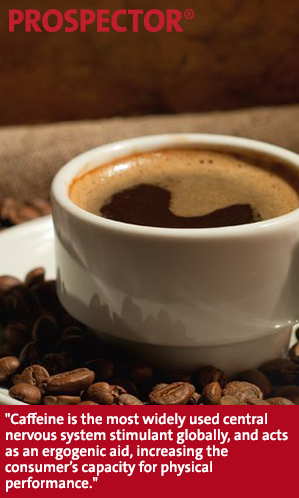Anyone entering a convenience store in the US can attest to the 
increased volume of energy products on the market. The regulatory and legal landscape is rocky at the moment for formulators considering an energy claim on their products. With this article, we will cover the specifics of the more common ingredients seen in the energy drink market.
As I was researching for this article, I found that the term “energy” encompasses much more than just the shot and energy drink market, and now is being used to refer to other ingredients like nuts and whole grains for sustainable energy throughout the day.
In the first of this two-part article, we will cover the top 3 energy ingredients in depth, we will cover other vitamins and amino acids added, as well as products that extend beyond the energy drink category.
Caffeine
Caffeine (EU) is the most widely used central nervous system stimulant globally, and acts as an ergogenic aid, increasing the consumer’s capacity for physical performance. While most people associate caffeine with a component of coffee, chocolate and teas, the majority of caffeine in energy drinks is manufactured. When added as a raw material, it is a bitter, white, crystalline powder.
The FDA has not developed comprehensive guidelines for caffeine, but has previously suggested 400 mg as an upper limit for daily consumption in consumer information. Current FDA regulations regarding caffeine use only defined limits for use in cola-type beverages. No other products have limits under this regulation. As for use in energy drinks, they are typically labeled as dietary supplements, which make them exempt to the 0.02% limit in the current regulation. To aid in determining if a product is a beverage or a supplement, the FDA reissued industry guidance in January 2014.
In the EU, caffeine must be labeled in the list of ingredients in products other than coffee or tea, and must be labeled as “high caffeine content” if the product contains more than 150 mg per liter. If the caffeine is added to a food supplement, it must be labeled as “contains caffeine.” No claims regarding caffeine have been authorized by the EFSA.
Taurine
Taurine (EU) is an amino acid that is produced by the body in the liver and brain using methionine and cysteine, and it typically present in fish and meat based foods. It aids in the regulation of heartbeat, muscle contraction, and energy levels in the body. Research on taurine in combination with caffeine showed that the blend improved the performance of sleep-deprived surgeons on laparoscopic surgical simulations, which may explain its addition to energy beverages. Conversely, there are also reports that taurine has a sedative effect, so formulators will need to determine if using it is appropriate for their products.
While the FDA has not approved taurine for use in conventional foods, it may be used in dietary supplements and is often seen added to infant formulas, as young infants lack the ability to produce it.
The EFSA concluded that taurine in energy drinks does not pose a safety concern. However, the EFSA has not authorized any packaging claims for taurine.
Guarana
Guarana (EU) is a plant native to South America and used by the Amazonian population to aid in improving alertness and energy. In addition to containing more caffeine than coffee, it also contains theobromine and theophylline, typically found in cocoa beans. It is sometimes added to weight loss supplements.
The FDA has approved guarana as a food additive for flavor use, but this is used at very low levels. As with taurine, guarana can be used in supplements.
The EFSA has rejected the following claims in regards to guarana: “helps to burn fat” when combined with green tea extract; acts as a natural antioxidant; protects organisms from oxidative damage; or contains powerful antioxidants beneficial to human health.
In part 2, we will continue a review of the common energy ingredients, look at products that extend beyond the energy drink market, and review the recent landscape of the past year.
The views, opinions and technical analyses presented here are those of the author or advertiser, and are not necessarily those of ULProspector.com or UL Solutions. The appearance of this content in the UL Prospector Knowledge Center does not constitute an endorsement by UL Solutions or its affiliates.
All content is subject to copyright and may not be reproduced without prior authorization from UL Solutions or the content author.
The content has been made available for informational and educational purposes only. While the editors of this site may verify the accuracy of its content from time to time, we assume no responsibility for errors made by the author, editorial staff or any other contributor.
UL Solutions does not make any representations or warranties with respect to the accuracy, applicability, fitness or completeness of the content. UL Solutions does not warrant the performance, effectiveness or applicability of sites listed or linked to in any content.



We are intaresting in salt tablets with electrolytes and caffeine – colud you have some formulations.
Coluld you have some formulation for natur sport gel with honey